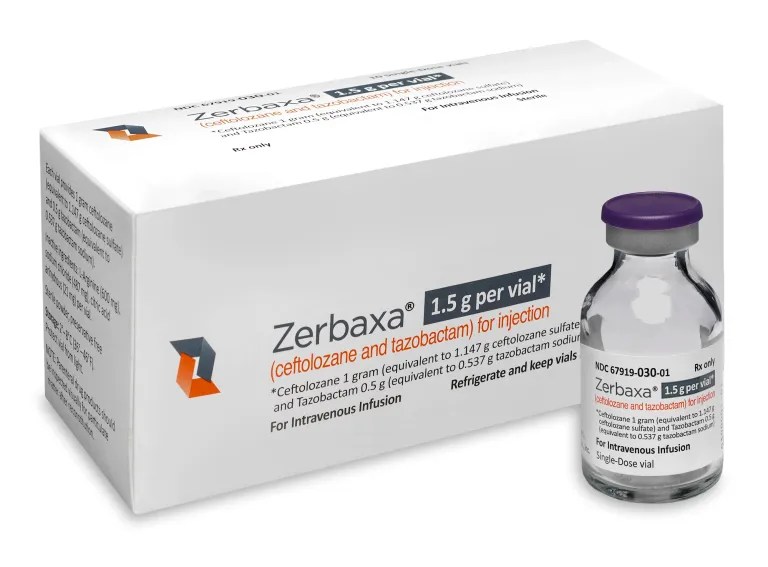Ordering ZERBAXA® (ceftolozane and tazobactam)
Learn about:
Wholesaler information
Product: ZERBAXA®
Packaging: Carton contains 10 single-dose vials
National Drug Code (NDC): 67919-030-01
Distributor order codes
| Distributor | Order code for ZERBAXA |
|---|---|
| BESSE MEDICAL | 10240631 |
| CARDINAL HEALTH | 5045810 |
| CENCORA | 10237721 |
| DMS PHARMACEUTICAL GROUP INC | 583420 |
| FFF ENTERPRISES | ZER003001 |
| HENRY SCHEIN | 5580056 |
| MCKESSON CORPORATION | 3971686 |
| MCKESSON MEDICAL SURGICAL | 1015050 |
| METRO MEDICAL | 661074 |
| MORRIS & DICKSON CO | 31179 |
| SMITH DRUG COMPANY | 737924 |
Merck does not recommend the use of one authorized distributor over another. Merck does not make any warranty as to the services offered by any particular distributor.
Package size and dimensions


Sales package size (carton)
10 single-dose (20 mL) vials
Carton dimensions
6 5/16 x 2 11/16 x 2 9/16 inches
Coding and billing information
This resource contains a list of possible codes that may be relevant when billing for ZERBAXA® (ceftolozane and tazobactam). Please consult with the applicable payer or, where applicable, the Medicare Administrative Contractor, to understand the payer’s specific billing requirements.
You are solely responsible for determining the appropriate codes and for any action you take in billing. Information about HCPCS codes is based on guidance issued by the Centers for Medicare & Medicaid Services (CMS) applicable to Medicare and may not apply to other public or private payers. Consult the relevant manual and/or other guidelines for a description of each code to determine the appropriateness for a particular code and for information on additional codes.
The information available here is compiled from sources believed to be accurate, but Merck makes no representation that it is accurate. This information is subject to change. Payer coding requirements may vary or change over time, so it is important to regularly check with each payer as to payer-specific requirements. The information available here is not intended to be conclusive or exhaustive, and is not intended to replace the guidance of a qualified professional advisor. Merck and its agents make no warranties or guarantees, expressed or implied, concerning the accuracy or appropriateness of this information for your particular use given the frequent changes in public and private payer billing. The use of this information does not guarantee payment or that any payment received will cover your costs.
HCPCS codes for ZERBAXA1
| HCPCS code | Description | Billing units |
|---|---|---|
| J0695 | Injection, ceftolozane 50 mg and tazobactam 25 mg | Each billing unit of ZERBAXA equals 50 mg of ceftolozane and 25 mg of tazobactam |
| S9502 | Home infusion therapy, antibiotic, antiviral, or antifungal therapy; once every 8 hours, administrative services, professional pharmacy services, care coordination, and all necessary supplies and equipment (drugs and nursing visits coded separately), per diem | N/A |
HCPCS, Healthcare Common Procedure Coding System; APC, ambulatory payment classifications.
Note: Paid under Outpatient Prospective Payment System (OPPS) as a separate APC payment.2
Use form CMS-1500 for in-office injection; in the hospital outpatient department setting, submit claims using form UB-04 (also known as CMS 1450).
For questions on billing if a portion of the package is wasted, consult the applicable payer’s policy regarding wastage. Please note that effective July 1, 2023, providers are required to use the JW modifier for Medicare claims with unused drugs or biologicals from single-use vials or single-use packages that are appropriately discarded.3
Drug administration current procedural terminology (CPT®) code4
| CPT code | 96365 |
| Description | Intravenous infusion, for therapy, prophylaxis, or diagnosis (specify substance or drug); initial, up to 1 hour |
CPT copyright © 2023 American Medical Association. All rights reserved. CPT is a registered trademark of the American Medical Association.
Possible revenue codes for use in the hospital inpatient and hospital outpatient settings5
Consult the relevant manual and/or other guidelines for a description of each code to determine the appropriateness of a particular code and for information on additional codes.
| Revenue code | Description |
|---|---|
| 0636 | Drugs requiring detailed coding |
| 0250 | General pharmacy |
You are solely responsible for determining the appropriate codes and for any action you take in billing. Merck and its agents make no warranties, express or implied, concerning the accuracy or appropriateness of this information for your particular use. The use of this information does not guarantee payment or that any payment received will cover your costs.
References
- Centers for Medicare & Medicaid Services. HCPCS Quarterly Update, January 2024. Accessed February 21, 2024. https://www.cms.gov/Medicare/Coding/HCPCSReleaseCodeSets/HCPCS-Quarterly-Update
- Centers for Medicare & Medicaid Services. Medicare Fee-For-Service Provider Utilization & Payment Data Outpatient Hospital Public Use File: A Methodological Overview. October 2022. Accessed March 11, 2024. https://www.cms.gov/Research-Statistics-Data-and-Systems/Statistics-Trends-and-Reports/Medicare-Provider-Charge-Data/Downloads/Outpatient_Methodology.pdf
- Centers for Medicare & Medicaid Services. Billing and Coding: JW and JZ Modifier Billing Guidelines (A55932). Revised January 10, 2023. Accessed March 12, 2024. https://www.cms.gov/medicare-coverage-database/view/article.aspx?articleid=55932
- American Medical Association. CPT Code/Relative Value Search- 96365. Accessed February, 21, 2024. https://www.aapc.com/codes/cpt-codes/96365
- Noridian Healthcare solutions. Revenue codes. Last updated June 28, 2022. Accessed February, 21, 2024.
https://med.noridianmedicare.com/web/jea/topics/claim-submission/revenue-codes
